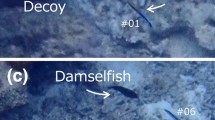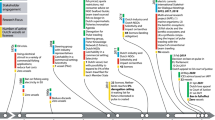Abstract
Touch pools are popular open-topped fish tanks often found in aquariums where visitors may interact with animals, by touching and sometimes even feeding them, for educational and recreational purposes. However, although animal interactions are becoming increasingly popular in recent years, the welfare impact on the animals and the educational effectiveness of such interactions is under debate. Awareness concerning the different, and sometimes controversial, aspects connected with such interactions has spread. The aim of this paper is to investigate the ethical issues arising from the presence of touch pools in aquariums and facilities alike. In particular, possible sources of moral conflicts between five interested parties will be identified and discussed: biodiversity; aquariums; staff involved with touch pools; individual animals used in the touch pools; visitors interacting with animals in touch pools. In order to assess the framework of ethical demands from different parties, it will be used an analytical tool provided by a revised version of the Ethical Matrix.
Similar content being viewed by others
Notes
EMs were first developed in Mepham (1996, 2000) to help the ethical assessment of biotechnologies and policies adopted in agriculture and food processing. EMs have since been successfully applied in several fields other than food ethics: on the issue see Millar (2013). For more information on the EM see Mepham et al. (2006) and Mepham (2010).
Broadly speaking, an EM is complete if it takes into account all the ethically relevant stakeholders involved in an issue; it is pluralist if it takes into account the different socially recognized general ethical principles; and it is neutral if the moral demands are acquired by taking into consideration the standpoint of each stakeholder. This means that, in filling an EM, we should be willing to consider standpoints and ethical commitments different from our own, in order to produce an objective description of the moral issues at stake.
It will be used a modified version of the general frame of the EM as it was originally devised by Mepham, in order to account for specific ethical aspects of the “triangular affair” between conservation, animal welfare, and human ethics. For a detailed account of this revised frame of the EM see Biasetti and de Mori (2019).
EMs can be filled in various ways. They can be filled through a top-down approach, carried out by “ethical experts” using their expertise to apply the principles to each stakeholder. Otherwise, EMs can be filled in through a bottom-up approach, carried out by insiders putting forth their various positions in debates and workshops on the issue. A third option is to combine these two approaches, starting top-down and refining bottom-up, or vice versa. In either case, the goal of the filling process should aim to clarify and reach transparent and consistent conclusions about the nature of the stakeholders and their moral demands. To discuss the topic of touch pools, we started top-down and refined bottom-up.
The EM is an all-inclusive tool, as it allows decision-makers to take into consideration both human and non-human standpoints, thus allowing for a comprehensive ethical analysis.
By the word “conservation”, we are referring to all scientifically grounded activities aimed at protecting, safeguarding and, eventually, restoring natural environments, ecosystems, wildlife, flora, and biodiversity. We also include efforts to educate people on the importance and value of biodiversity. For a sketch of the different values involved in conservation practices see Biasetti and de Mori (2016).
Some have proposed different sets of general ethical principles to be used in EM, considering the original list biased, [see, for instance, Schroeder and Palmer (2003) and the reply contained in Mepham (2010)], or inadequate for analyzing particular situations (see Kaiser and Forsberg 2001). As we do not believe that the original set is biased or inadequate, we will stick with it. However, we will specify the principle of justice in its particular meaning of “fairness”, in order to be clearer on how it should be applied.
We obviously lack clear scientific data concerning the capacity to suffer of non-fish species used in touch-pools. Without direct contrary evidence, then, there is a non-zero probability that the welfare of these animals can be impaired by captivity and improper interaction with people. This means that we ought to avoid trying to answer the issue around their capacity to suffer a priori, and follow a precautionary principle concerning their welfare instead.
References
Allen, C. (2013a). Ethics, laws, and the science of fish welfare. Between the Species: An Electronic Journal for the Study of Philosophy and Animals,16(1), 68–85.
Allen, C. (2013b). Fish cognition and consciousness. Journal of Agricultural and Environmental Ethics,26(1), 25–39.
Ashley, P. J. (2007). Fish welfare: Current issues in aquaculture. Applied Animal Behaviour Science,104(3–4), 199–235.
Biasetti, P., & de Mori, B. (2016). A framework of values: Reasons for conserving biodiversity and natural environments. Etica and Politica/Ethics and Politics,13(3), 527–545.
Biasetti, P., & de Mori, B. (2019). Le matrici etiche nella conservazione della biodiversità. Etica & Politica/Ethics & Politics,21(1), 233–254.
Braithwaite, V. (2010). Do fish feel pain?. Oxford: Oxford University Press.
Braithwaite, V., & Huntingford, F. A. (2004). Fish and welfare: Do fish have the capacity for pain perception and suffering. Animal Welfare,13, S87–S92.
Branson, E. J. (Ed.). (2008). Fish welfare. Oxford: Blackwell.
Broom, D. M. (2014). Sentience and animal welfare. Oxfordshire: CABI.
Broom, D. M. (2016). Fish brains and behavior indicate capacity for feeling pain. Animal Sentience: An Interdisciplinary Journal on Animal Feeling,1(3), 1–6.
Brown, C. (2015). Fish intelligence, sentience, and ethics. Animal Cognition,18(1), 1–17.
Casamitjana, J. (2004). Aquatic zoos: A critical study of UK public aquaria in the year 2004. New York: The Captive Animal’s Protection Society.
Chandroo, K. P., Duncan, I. J. H., & Moccia, R. D. (2004a). Can fish suffer? Perspectives on sentience, pain, fear, and stress. Applied Animal Behaviour Science,86(3–4), 225–250.
Chandroo, K. P., Yue, S., & Moccia, R. D. (2004b). An evaluation of current perspectives on consciousness and pain in fishes. Fish and Fisheries,5(4), 281–295.
Dawkins, M. (2015). Animal welfare and the paradox of animal consciousness. Advances in the Study of Behavior,47, 5–38.
Fraser, D. (2008). Understanding animal welfare: The science in its cultural context. Oxford: Wiley.
Fraser, D., Weary, D. M., Pajor, E. A., & Miligan, B. N. (1997). A scientific conception of animal welfare that reflects ethical concerns. Animal Welfare,6, 187–205.
Grossman, R. (2005). Stereotypical surface breaking behaviour in captive rays (genus: Raja) at the London aquarium. In A. Nicklin (Ed.), Proceedings of the 7th annual symposium on zoo research, Twycross Zoo, Warwickshire, UK, 7–8th July 2005 (pp. 175–187). London: British and Irish Association of Zoos and Aquariums.
Huntingford, F. A., Adams, C., Braithwaite, V. A., Kadri, S., Pottinger, T. G., Sandøe, P., et al. (2006). Current issues in fish welfare. Journal of Fish Biology,68(2), 332–372.
Johnson, J. G., Naples, L. M., Van Bonn, W. G., Kent, A. D., Mitchell, M. A., & Allender, M. C. (2017). Evaluation of health parameters in cownose rays (Rhinoptera bonasus) housed in a seasonal touch pool habitat compared with an off-exhibit habitat. Journal of Zoo and Wildlife Medicine,48(4), 954–960.
Kaiser, M., & Forsberg, E. M. (2001). Assessing fisheries—Using and Ethical Matrix in a participatory process. Journal of Agricultural and Environmental Ethics,14(2), 191–200.
Kearns, P. J., Bowen, J. L., & Tlusty, M. F. (2016). The skin microbiome of cow-nose rays (Rhinoptera bonasus) in an aquarium touch-tank exhibit. Zoo Biology,36(3), 226–230.
Lund, V., Mejdell, C. M., Röcklinsberg, H., Anthony, R., & Håstein, T. (2007). Expanding the moral circle: Farmed fish as objects of moral concern. Diseases of Aquatic Organisms,75(2), 108–118.
Martins, C. I. M., Galhardo, L., Noble, C., Damsgård, B., Spedicato, M. T., Zupa, W., et al. (2012). Behavioral indicators of welfare in farmed fish. Fish Physiology and Biochemistry,38(1), 17–41.
Mellor, D. J. (2016). Updating animal welfare thinking: Moving beyond the “Five Freedoms” towards “A Life Worth Living”. Animals,6(3), 21.
Mellor, D. J. (2017). Operational details of the five domains model and its key applications to the assessment and management of animal welfare. Animals,7(8), 60.
Mellor, D. J., & Beausoleil, N. J. (2015). Extending the ‘Five Domains’ model for animal welfare assessment to incorporate positive welfare states. Animal Welfare,24(3), 241–253.
Mellor, D. J., & Reid, C. S. W. (1994). Concepts of animal well-being and predicting the impact of procedures on experimental animals. Improving the well-being of Animals in the Research Environment. In R. M. Baker, G. Jenkin, & D. J. Mellor (Eds.), Improving the well-being of animals in the research environment (pp. 3–18). Glen Osmond: Australian and New Zealand Council for the care of Animals in Research and Teaching.
Mepham, B. (1996). Ethical analysis of food biotechnologies: An evaluative framework. In B. Mepham (Ed.), Food Ethics (pp. 115–133). London: Routledge.
Mepham, B. (2000). A framework for the analysis of novel foods: The Ethical Matrix. Journal of Agricultural and Environmental Ethics,12(2), 165–176.
Mepham, B. (2010). The Ethical Matrix as a tool in policy interventions: The obesity crisis. In F. T. Gottwald, H. W. Ingensiep, & M. Meinahrdt (Eds.), Food ethics. Dordrecht: Springer.
Mepham, B., Kaiser, M., Thorstensen, E., Tomkins, S., & Millar, K. (2006). Ethical Matrix manual. The Hague: LEI.
Millar, K. (2013). Ethics and ethical analysis in veterinary science: The development and application of the Ethical Matrix method. In C. M. Whates, S. A. Corr, S. A. May, S. P. McCulloch, & M. C. Whiting (Eds.), Veterinary and animal ethics. Proceedings of the 1st international conference on veterinary and animal ethics UFAW (pp. 100–112). London: Wiley.
Miller, L. J., Mellen, J., Greer, T., & Kuczaj, S. A. (2011). The effects of education programmes on Atlantic bottlenose dolphin (Tursiops truncatus) behaviour. Animal Welfare,20(2), 159–172.
Miller, L. J., Zeigler-Hill, V., Mellen, J., Koeppel, J., Greer, T., & Kuczaj, S. (2013). Dolphin shows and interaction programs: Benefits for conservation education? Zoo Biology,32(1), 45–53.
Ogle, B. (2016). Value of guest interactions in touch pools at public aquariums. Universal Journal of Management,4(2), 59–63.
Rowe, S., & Kiesel, J. (2012). Family engagement at aquarium touch tanks—Exploring interactions and the potential for learning. In E. Davidsson & A. Jakobsson (Eds.), Understanding interactions at science centers and museums. Approaching sociocultural perspectives (pp. 63–77). Rotterdam: Sense Publishers.
Sahrmann, J. M., Niedbalski, A., Bradshaw, L., Johnson, R., & Deem, S. L. (2016). Changes in human health parameters associated with a touch tank experience at a zoological institution. Zoo Biology,35(1), 4–13.
Schroeder, D., & Palmer, C. (2003). Technology assessment and the “Ethical Matrix”. Poiesis and Praxis,1(4), 295–307.
Scott, G. W., Hull, S. L., & Rollinson, D. J. (1999a). Surface breaking behavior in a population of captive rays Raya: The expression of a need to forage? Aquarium Science and Conservation,2(3), 161–169.
Scott, G. W., Rollinson, D. J., & Hull, S. L. (1999b). Modification in feeding regime reduces the performance of surface breaking behavior in a population of captive ray (Raya). Aquarium Sciences and Conservation,2(3), 171–174.
Timmons, M., Muir, C., Schlein, P., & Finkle, S. (2001). Tiny Hands and Shattered Arms: How Kids Affect Sea Star Regeneration in Touch Tanks. Communiqué American Zoo and Aquarium Association, December, 9.
WAZA. (2015). Guidelines for the use of animals in visitor interactions. Gand: WAZA Executive Office. http://www.zoosafrica.com/about/projects.html. Accessed 20 May 2019.
Webster, J. (2005). The assessment and implementation of animal welfare: Theory into practice. Revue Scientifique et Technique-Office International Des Epizooties,24(2), 723–734.
Webster, J. (Ed.) (2011). Management and welfare of farm animals. The UFAW Farm Handbook (Vth Ed.) (UFAW Series). London: Wiley-Blackwell.
Author information
Authors and Affiliations
Corresponding author
Additional information
Publisher's Note
Springer Nature remains neutral with regard to jurisdictional claims in published maps and institutional affiliations.
We thank Linda Ferrante for her help with the final draft of this paper.
Rights and permissions
About this article
Cite this article
Biasetti, P., Florio, D., Gili, C. et al. The Ethical Assessment of Touch Pools in Aquariums by Means of the Ethical Matrix. J Agric Environ Ethics 33, 337–353 (2020). https://doi.org/10.1007/s10806-020-09823-2
Accepted:
Published:
Issue Date:
DOI: https://doi.org/10.1007/s10806-020-09823-2




